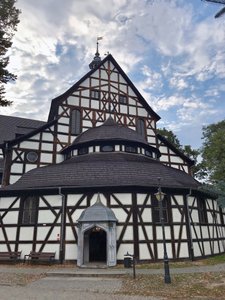Advertisement
Published: January 9th 2023

 Kościół Pokoju - Church of Peace
Kościół Pokoju - Church of Peace
Holy Trinity Evangelical Church. Kościół Pokoju - Church of Peace in Świdnica. Built of wood so it could be taken down quickly if the authorities so warranted. Constructed 1656-1657.
"The Churches of Peace located in the towns of Jawor and Świdnica in the Silesia region of south-western Poland are the largest timber-framed Baroque ecclesiastical buildings in Europe. They were built in the mid-17th century to a scale and complexity unknown in European wooden architecture before or since, following the provisions of the Peace of Westphalia, which concluded the Thirty Years’ War in 1648".
Churches of Peace in Jawor and Świdnica UNESCO World Heritage site. Inscribed in 2001.
"The Prot. Friedens-Kirche was completed in 1658".--Baedeker 1910.
IMG_5691The Collette tour offered an optional evening excursion to Świdnica to see the Church of Peace. Of course, Susan and I wanted to see it. It's a UNESCO World Heritage site. The group left Wrocław about 3:30 p.m. and reached Świdnica an hour later. The route led past the scenic foothills of Lower Silesia, though the ranges remained in the distance. The Churches of Peace (Friedenskirchen or Kościoły Pokoju) were built following the Peace of Wesphalia in 1648. (The treaty that ended the Thirty Years' War.) Protestants in Silesia were permitted to build three churches outside of city walls, in Świdnica, Jawor and Glogau. They had to be built of wood and clay, with no spires or towers, lest they be required to be dismantled, and constructed within one year. Despite these limitations, the Lutherans created magnificent wooden Baroque edifices.
Holy Trinity Evangelical Church in Świdnica was completed in 1657. The church is set off in its own wooded park, entered via a gateway. A freestanding wooden bell tower built in 1708 sits apart from the church. On the outside the church appears as a large

 Holy Trinity Evangelical Church Gate
Holy Trinity Evangelical Church Gate
Entrance gate to the Church of Peace in Świdnica.
DSC_0008half-timbered structure. The entrance takes the form of a rounded chancel. (It is the largest wooden church in Europe.) But inside, craftsmen reached a high Baroque style working only with wood and paint. Lutheran churches in Europe tend to have quite plain interiors. This one is decidedly not plain. The interior is in the form of a Greek cross with the high altar at one end of the nave facing the organ loft at the other. A two-tier gallery decorated with scrollwork, memorials and texts from scripture encircles the nave and its wooden pews. We were treated to an organ concert while here, played on the church's 17th century instrument.
The Churches of Peace in Jawor and Świdnica is a UNESCO World Heritage site.
After visiting the church, the group stayed for dinner at Karczma Zagłoba in Świdnica.
Karczma means inn or tavern in Polish. We were in for a hearty Silesian dinner here. The restaurant is decorated in the manner of a hunting lodge. Duck is a speciality and so the meal began with Duck Pâté. The soup course was Potato Soup with Silesian Dumplings. On to the main course, Duck with Silesian Dumplings and Beets.
Advertisement
Tot: 0.118s; Tpl: 0.014s; cc: 12; qc: 33; dbt: 0.077s; 1; m:domysql w:travelblog (10.17.0.13); sld: 1;
; mem: 1.1mb

 Kościół Pokoju - Church of Peace
Kościół Pokoju - Church of Peace
 Holy Trinity Evangelical Church Gate
Holy Trinity Evangelical Church Gate















































D MJ Binkley
Dave and Merry Jo Binkley
Poland and beyond
I'm keen to go to Poland soon. I've enjoyed this blog.